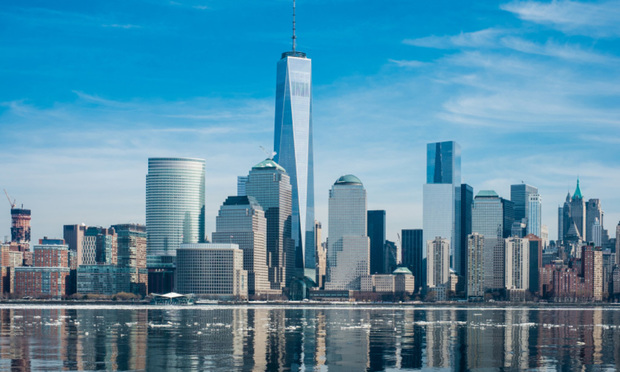Development on Hudson River Pier
On May 5, the New Jersey Supreme Court decided a case that involved a substantial change to a development plan on the Hudson River waterfront in Hoboken. The ruling addressed issues of interest to both land use and environmental attorneys.
June 03, 2020 at 12:00 PM
7 minute read
 iStock
iStock
On May 5, the New Jersey Supreme Court decided a case that involved a substantial change to a development plan: replacing a proposed tennis facility with two 11-story residential buildings on a platform that extended into the Hudson River. Shipyard Associates L.P. v. City of Hoboken, 2019 WL 149532 (App. Div. 2019), aff'd 2020 WL 2120903 (Shipyard III). The ruling addressed issues of interest to both land use and environmental attorneys.
Shipyard III is the latest decision in a long-running dispute between objectors—the Hudson Tea Buildings Condominium (Hudson Tea), a high-end condominium development whose residents were concerned with preserving their views of the River and the Manhattan skyline; a nonprofit organization dedicated to securing a waterfront park; and the City of Hoboken—and a developer (Shipyard) seeking to complete construction of a planned unit development consisting of a large mixed-use project. Reduced to its essence, the case was about the loss of views and recreational facilities that would result from the construction of two high-rise buildings on a pier in the River.
Shipyard I and II
Due to its proximity to navigable water, the development required a waterfront development permit (WDP) from the Department of Environmental Protection (DEP). N.J.S.A. 12:5-3. In 2011, DEP granted its approval and Hudson Tea and the City sought an evidentiary hearing to challenge that determination. The agency has never been a fan of third-party hearing requests and, true to form, denied this one in 2014 on the grounds that the requesting parties lacked a statutory or constitutional right to such relief. The Appellate Division agreed jn In re Shipyard Assocs. L.P. Waterfront Dev. Permit, 2017 WL 461300, certif. denied, 230 N.J. 397 (2017) (Shipyard I).
In 2019, the governor approved a measure that provided statutory status to the public trust doctrine (PTD). It instructed DEP to protect the public's right of access to tidal waters and adjacent shores "to the greatest extent practicable" and ensure that WDPs approved in the future are consistent with the PTD. N.J.S.A. 13:1D-150(e); -151(a).7. Whether the WDP application would have been handled differently by the DEP under the new statutory regime remains an open question. For additional discussion of the PTD statute, see L. Goldshore, "Public Trust Doctrine Legislation: Codifying the Common Law Principle," 225 N.J.L.J. 1198 (May 13, 2019).
The issue in Shipyard II, Shipyard Assocs. L.P. v. Hoboken Planning Bd., 2017 WL 3271976, certif. denied, 232 N.J. 106 (2018), concerned the developer's efforts to secure municipal, rather than state, approval. While other issues were being addressed, an application was filed in 2011 with the local planning board to switch out the tennis facility for the high-rise buildings. In 2012, the board denied the application without prejudice premised on the mistaken assertion that it lacked jurisdiction due to pending litigation.
The board's failure to act on a complete application within 120 days of submission triggered the Municipal Land Use Law's (MLUL) automatic approval provision and resulted in a two-year period of protection (vested rights) from changes in zoning requirements. N.J.S.A. 40:55D-61 (established the 120-day period for planning boards to rule on complete applications); 40:55D-52(a) (providing a two-year period of repose from zoning requirement changes following final approval). According to the Appellate Division's critique:
If there is a lesson to be learned from this case, it is that the rule of law is paramount and cannot be sidestepped to avoid deciding unpopular land use applications. … Ironically, had the Board considered the application on its merits, it had authority to deny the application unless Shipyard's evidence justified modifying the original PUD which included the tennis courts. But, because the Planning Board yielded to public pressure, and refused to hear Shipyard's application, the result is automatic approval of the application.
Shipyard III
In late 2013, while the other challenges to the development were pending, the City took a different tack and adopted two ordinances designed to prohibit construction on piers/platforms extending into the river. One of the local enactments (Z-264), designated as a zoning ordinance, prohibited such construction while the other (Z-263), characterized by the City as a general environmental regulation, restricted development seaward of the mean high tide to water-dependent uses, open space and recreational uses.
The City argued that Z-263 was grounded on the municipality's police power, rather than on its zoning authority, and was not subject to the period of protection from zoning changes provided pursuant to section 52(a). The Supreme Court observed that the resolution of the issue did not turn on "how the municipality characterizes the ordinance, but also how the ordinance functions in practice." Applying that test, it concluded "that Z-263 is a zoning ordinance because its provisions set specific, methods, and uses governing construction—should it occur at all."
The City's alternative argument was that the vested rights conveyed by section 52(a) were not exempt from the retroactive application of public health and safety ordinances. But the MLUL sections relied on by the municipality for this proposition were limited to "application[s] for development" (section 10.5) and "preliminary approval[s]" (section 49(a)) rather than to final approvals—the status attained by the developer. As the court concluded:
[Z]oning ordinances affecting public health and safety may govern applications for development, N.J.S.A. 40:55D-10.5, but municipalities may only "modify [ ] by ordinance such general terms and conditions of preliminary approval," N.J.S.A. 40:55D-49(a) (emphasis added), and the MLUL makes no provision for municipalities to apply new zoning ordinances to final approvals, N.J.S.A. 40:55D-52(a).
Lastly, the court considered the application of the MLUL's tolling provision, which suspends the running of an approval period when a legal action brought by a governmental agency to protect the public health and welfare prevents a developer from proceeding with a development. N.J.S.A. 40:55D-21. The court found that since July 2012, when Shipyard received final approval, it has been unable to complete its development due to the City's legal actions and that, as a result, the two-year period of protection against changes in zoning requirements under section 52(a) had been tolled.
Land Swap in the Works
The court's opinion ended more than eight years of litigation. It also underscored the obligation of land use boards to hear and decide controversial applications within the time period specified in the MLUL, as well as the extent of the protection accorded to vested rights by the statute. But that does not appear to be the end of the story for the Shipyard site.
On the same day as the court's opinion was released, the City issued a press release that advised that it had previously entered into a settlement agreement with the developer. The terms of the settlement are subject to a redevelopment agreement that the City and the developer are in the process of negotiating. www.hobokenj.gov/news/.
The major elements of the agreement include a land swap pursuant to which the developer will transfer the waterfront site to the City for public open space purposes. In exchange, the developer would be provided with the right to develop an inland site in the municipality for mixed uses.
Lewis Goldshore practices in Princeton. His practice is devoted to environmental, land use and municipal law. He is the author of New Jersey Environmental Law (ICLE 2010).
This content has been archived. It is available through our partners, LexisNexis® and Bloomberg Law.
To view this content, please continue to their sites.
Not a Lexis Subscriber?
Subscribe Now
Not a Bloomberg Law Subscriber?
Subscribe Now
NOT FOR REPRINT
© 2025 ALM Global, LLC, All Rights Reserved. Request academic re-use from www.copyright.com. All other uses, submit a request to [email protected]. For more information visit Asset & Logo Licensing.
You Might Like
View All
Social Media Policy for Judges Provides Guidance in a Changing World
3 minute read
Bank of America's Cash Sweep Program Attracts New Legal Fire in Class Action
3 minute read
'Something Really Bad Happened': J&J's Talc Bankruptcy Vote Under Attack
7 minute readTrending Stories
- 1South Florida Attorney Charged With Aggravated Battery After Incident in Prime Rib Line
- 2'A Death Sentence for TikTok'?: Litigators and Experts Weigh Impact of Potential Ban on Creators and Data Privacy
- 3Bribery Case Against Former Lt. Gov. Brian Benjamin Is Dropped
- 4‘Extremely Disturbing’: AI Firms Face Class Action by ‘Taskers’ Exposed to Traumatic Content
- 5State Appeals Court Revives BraunHagey Lawsuit Alleging $4.2M Unlawful Wire to China
Who Got The Work
J. Brugh Lower of Gibbons has entered an appearance for industrial equipment supplier Devco Corporation in a pending trademark infringement lawsuit. The suit, accusing the defendant of selling knock-off Graco products, was filed Dec. 18 in New Jersey District Court by Rivkin Radler on behalf of Graco Inc. and Graco Minnesota. The case, assigned to U.S. District Judge Zahid N. Quraishi, is 3:24-cv-11294, Graco Inc. et al v. Devco Corporation.
Who Got The Work
Rebecca Maller-Stein and Kent A. Yalowitz of Arnold & Porter Kaye Scholer have entered their appearances for Hanaco Venture Capital and its executives, Lior Prosor and David Frankel, in a pending securities lawsuit. The action, filed on Dec. 24 in New York Southern District Court by Zell, Aron & Co. on behalf of Goldeneye Advisors, accuses the defendants of negligently and fraudulently managing the plaintiff's $1 million investment. The case, assigned to U.S. District Judge Vernon S. Broderick, is 1:24-cv-09918, Goldeneye Advisors, LLC v. Hanaco Venture Capital, Ltd. et al.
Who Got The Work
Attorneys from A&O Shearman has stepped in as defense counsel for Toronto-Dominion Bank and other defendants in a pending securities class action. The suit, filed Dec. 11 in New York Southern District Court by Bleichmar Fonti & Auld, accuses the defendants of concealing the bank's 'pervasive' deficiencies in regards to its compliance with the Bank Secrecy Act and the quality of its anti-money laundering controls. The case, assigned to U.S. District Judge Arun Subramanian, is 1:24-cv-09445, Gonzalez v. The Toronto-Dominion Bank et al.
Who Got The Work
Crown Castle International, a Pennsylvania company providing shared communications infrastructure, has turned to Luke D. Wolf of Gordon Rees Scully Mansukhani to fend off a pending breach-of-contract lawsuit. The court action, filed Nov. 25 in Michigan Eastern District Court by Hooper Hathaway PC on behalf of The Town Residences LLC, accuses Crown Castle of failing to transfer approximately $30,000 in utility payments from T-Mobile in breach of a roof-top lease and assignment agreement. The case, assigned to U.S. District Judge Susan K. Declercq, is 2:24-cv-13131, The Town Residences LLC v. T-Mobile US, Inc. et al.
Who Got The Work
Wilfred P. Coronato and Daniel M. Schwartz of McCarter & English have stepped in as defense counsel to Electrolux Home Products Inc. in a pending product liability lawsuit. The court action, filed Nov. 26 in New York Eastern District Court by Poulos Lopiccolo PC and Nagel Rice LLP on behalf of David Stern, alleges that the defendant's refrigerators’ drawers and shelving repeatedly break and fall apart within months after purchase. The case, assigned to U.S. District Judge Joan M. Azrack, is 2:24-cv-08204, Stern v. Electrolux Home Products, Inc.
Featured Firms
Law Offices of Gary Martin Hays & Associates, P.C.
(470) 294-1674
Law Offices of Mark E. Salomone
(857) 444-6468
Smith & Hassler
(713) 739-1250







